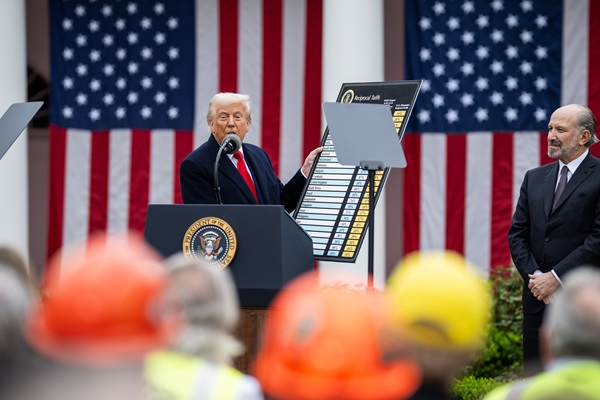.png)

Manoj Rane, who headed treasury at various foreign and domestic banks, was vice chair of FIMMDA and FEDAI. He is now an independent director advising finance firms.
May 12, 2025 at 12:37 PM IST
The headlines were unmistakably grand. President Donald Trump declared a “very big” trade deal with the UK, repeating the phrase for emphasis, as evidence that his new reciprocal tariff regime was starting to deliver. But as with most things in Trumpworld, the fine print underwhelms. What the US and the UK have struck is not a deal, but an agreement to someday have a deal.
The broader context matters. Roughly halfway through the 90-day window, Trump himself set for negotiations with America’s major trading partners, the administration has precious little to show. The UK pact, thin as it is, appears to have been rushed out under pressure to claim a win — any win — before the clock runs out.
Yet the numbers do not lie. The UK accounts for just 3% of America’s total trade and ranks 11th among its partners. The US, in fact, runs a trade surplus with Britain. This is hardly the stuff of high-stakes rebalancing. Under the announcement, the US will maintain a baseline 10% tariff on UK imports and expects to collect $6 billion in duties. In return, US exporters hope to ship $5 billion more in goods to Britain. The math is not transformative, and the timeline for implementing any of this remains vague — in the coming weeks or months.
Even politically, the move is awkward. When asked whether the agreement improved the UK’s position compared to six months ago, Prime Minister Keir Starmer coyly replied that it was “better than what we had yesterday” — a masterclass in diplomatic non-answers.
Auto manufacturers in the US, meanwhile, are unhappy. The deal is seen to favour luxury brands like Rolls Royce, which sold just 1,600 cars in America last year, to the detriment of domestic players. Markets were also unimpressed. After a brief uptick, indices gave back most of their gains the very next day.
All this reinforces the view that Trump’s tariff crusade may be slowly unravelling. The economic damage is becoming harder to ignore. Major US ports are reporting cargo arrivals down by nearly two-thirds. Retailers warn of looming shortages and price hikes. Inflation expectations are firming just as the Federal Reserve remains cornered by political heat and monetary fatigue. Fed Chair Jerome Powell has reportedly voiced concern over the inflationary impact of the blanket 10% tariff.
At the heart of it all is China. Until recently, Beijing had shown little inclination to negotiate, holding firm while other countries scrambled to seek exemptions. That changed in Geneva. After high-level talks, US Treasury Secretary Scott Bessent and Trade Representative Jamieson Greer announced a 90-day truce with Chinese Vice Premier He Lifeng.
Both sides will reduce duties considerably during the truce and will set up a new consultative mechanism to address bilateral economic issues— a face-saving compromise that would signal de-escalation without appearing to fold.
This is likely to be the pattern going forward: a string of half-formed deals, modelled on the UK template, where timelines are fuzzy and details deferred. Both sides will claim victory. Trump will say he restored American leverage; trading partners will say they avoided the worst. Such optics help restore calm without walking back the administration’s rhetoric — or at least, not overtly.
Yet, the political cost may still bite. The optics of victory do not always compensate for the experience of inflation or shortages. Consumers rarely rally around baseline tariffs. They react to what is on the shelves and how much it costs.
If Trump insists on retaining a 10% universal tariff to avoid the appearance of retreat, the US economy could be saddled with a built-in inflation premium. That would further complicate the Fed’s path at a time when interest rate decisions are already caught in the crossfire of monetary constraint and political pressure.
For all the early sound and fury, Trump’s trade war may end not with a bang, but with a series of anticlimactic announcements and carefully crafted climbdowns. That may be preferable to full-blown confrontation, but it still exposes the central contradiction in his approach: you cannot demand payback from allies and rivals alike while simultaneously claiming that all sides are winning.
What we are witnessing may not be a strategy but a story arc — from provocation to negotiation to retreat, dressed up as a string of triumphs.




